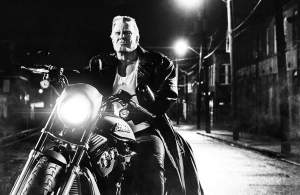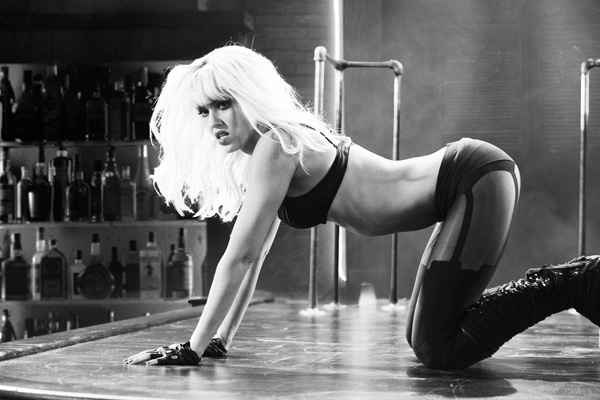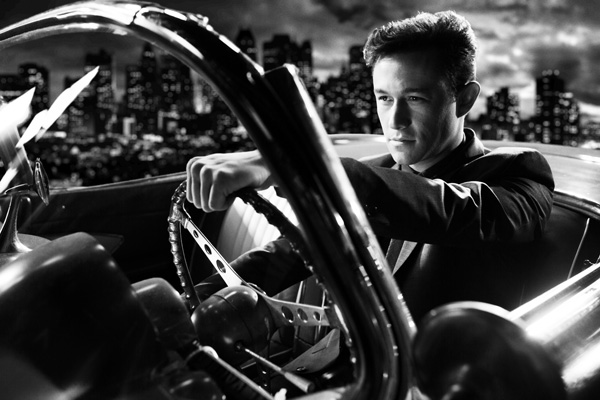
Writer/artist/co-director Frank Miller and co-director/cinematographer/editor Robert Rodriguez return to their high-contrast black and white hyper-noir world with a collection of stories that take place before and after the original.

Coming nine years after Sin City there’s the danger of A Dame to Kill For feeling old hat, like an embarrassing mid-2000s adolescent indulgence we’ve all outgrown, the same way the eight-year gap between 300 films did the second one no favours.
Rodriguez pushes the style further, shooting with even less of a set and even fewer props (generally only things the characters interact with, like doorways, were made while the rest, including all the walls, are computer generated).
This gives him the freedom for so many fun visual tricks, playing with wind, snow and blood elements, silhouettes, perspective, and even smaller images inset into the frame like panels. (The 3D helps - it doesn’t add depth to the characters but does draw you into their world.)
A few examples: at the beginning Marv wakes up from a car crash, and as he’s recovering he’s narrating how it happened, and as he’s narrating the cars drive around his head and hands, crashing into each other; Eva Green dives into a pool, shot sideways on a black background so her and her reflection are propelled towards each other until they break the white line of the water surface.
Rodriguez could and should have pushed this further. It’s a comic book world and in emulating Frank Miller’s exaggerated art work it can become totally expressionistic.

There are still so many other pleasures in returning to Sin City. The film’s style is so over the top it’s difficult to help enjoying it, especially the car-racing, bone-crunching, head-rolling and eye-popping violence. The sexuality is similarly over-cranked, with Eva Green’s alleged powers of seduction revealed as a function of her being naked constantly, the protective hookers of Old Town, and a hilarious moment of phallic gun stroking. It’s not important if you’re laughing with it or you’re laughing at it.
However there are also long, dull stretches, dialogue scenes that could be trimmed from minutes to seconds. In any other film, scenes where we learn about the characters' back stories would be interesting but here they deflate the atmosphere.
Nancy’s story suffers in particular from a returning uninterested and uninteresting Bruce Willis, Jessica Alba’s extremely limited range as an actress and a reliance on remembering and caring about the events of the previous film (it’s the only story set after the first one).
Some of the transitions are incredibly clumsy and the four stories never come together in a truly satisfying way.
The repetitiveness and familiarity gradually sinks in; “walk down the right back alley in Sin City and you can find anything” is simply not true any more. Sin City’s charm as a displaced ‘50s crime dystopia is also why this film can never be satisfying - nothing changes.

The worst Robert Rodriguez films - Once Upon a Time In Mexico, Machete Kills - are saturated with characters, none of them too interesting or too developed, because he'll get actors for a few days and shoot one scene around them without considering whether it adds to the film.
With the Sin City films this approach actually works. You can have Ray Liotta, Juno Temple, Christopher Lloyd and Lady Gaga pop up for half a scene each and their digressions are not only welcome but easily the best parts of the film. The caricatures that live in this world hold up much better for a few minutes at a time than at long stretches.
That said, some actors fit in better than others. Joseph Gordon-Levitt totally understands what’s required of him and you get the sense that the technique and style are actually liberating rather than constraining him. Eva Green walks a fine line between great and terrible. Her accent slips in her first scene, but apart from that she exaggerates her performance too much, as if she doesn’t believe in the world she’s in, when everyone else plays it straight and leaves it up to us to laugh.
Josh Brolin should slip right into this world but again his presence is awkward and lacks the charisma of Clive Owen in the same role. Once again Mickey Rourke as Marv is the highlight.
Sin City: A Dame to Kill For will still satisfy fans of the first, although it has serious flaws and brings little new to this universe.
Sin City: A Dame to Kill For is in cinemas from August 22.